Out of every 10,000 diamonds, just one will have natural color, which is known as a fancy color diamond. The value of a fancy color diamond therefore lies in the intensity and distribution of its color. Other factors that normally matter a great deal with colorless diamonds, like cut grade and clarity, are not top priority in fancy color diamonds.
As mentioned, colored diamonds are known in the jewellery trade as "fancy diamonds". They are available in an array of colors, tones and saturations, some are certainly more rare than others, but overall colored diamonds are far more rare than their colorless counterparts.

Colored diamond value.
Unlike colorless diamonds and their GIA certificates, it is ideal to view a video of a colored diamond before you choose so you can see how it looks while it moves because colors and their saturation can vary so greatly. colored diamonds tend to rely on a more intuitive response, rather than a technical diamond grading report.
While round diamonds are a classic and traditional choice for engagement rings , this shape does not lend itself best to colored diamonds as they don't display the color tones as well as a radiant or cushion cut diamond, for example. While colored diamonds carry a price premium, a great way to feature them in your design is to use them on the band or in the halo.
Color is the most important aspect of any fancy color diamond. Fancy color diamonds can have one or more colors. When only one color exists in the diamond, the price will be much higher than if it were to have multiple colors. So it goes without saying that a Fancy Blue will cost more than a Fancy Grayish Blue and a Fancy Pink will command a higher price than a Fancy Orangey Pink. Aside from primary and secondary colors, also referred to as overtones, in fancy color diamonds, color is based on the level of intensity. Whereas colorless diamonds are graded on a D-Z scale, fancy color diamonds are evaluated on an intensity scale that runs as follows. Understandably, the higher the intensity, the higher the price:
| Colored Dimaonds Intensity Scale |
|---|
| Faint |
| Very Light |
| Light |
| Fancy Light |
| Fancy |
| Fancy Intense |
| Fancy Vivid |
| Fancy Deep |
| Fancy Dark |
Colored dimaonds intensity scale.
To get a better understanding of how fancy color diamonds acquire their color, a bit of scientific discussion is in order. Firstly, natural color in natural fancy color diamonds is formed when trace amounts of other elements combine with the standard quantity of carbon during the crystallization process. Mutations in the basic crystalline structure of the diamond also contribute to the formation of natural color. If any secondary elements fuse with the carbon as it crystallizes, the color in the resulting composition can change. Other factors that can affect the natural color of a fancy color diamond are radiation and additional pressure applied to the crystalline structure. See detailed description below:
| Diamond Color | Common Causes Of Color In Diamond |
|---|---|
| Yellow | Yellow is the second most common natural color in diamonds. The color is usually caused by nitrogen atoms substituting for carbon in the diamond crystal lattice. This defect causes diamond to selectively absorb blue light and selectively transmit yellow. |
| Pink | Pink is a rare natural color in diamonds. It occurs when the diamond is subjected to stress within the Earth, and those forces cause glide planes of carbon atom displacement within the diamond crystal. When light passes through the planes, red light is selectively transmitted. The red light appears pink when the selective transmission is weak. The selective transmission is rarely strong enough to produce a red color. |
| Purple | Purple is another rare color in diamond. In a study of 50 purple diamonds by GIA, they often found H3 and N3 color centers, sufficient enough to influence color. Purple diamonds and some pink diamonds modified by purple often exhibit color concentration along glide planes of carbon atom displacement. |
| Blue | Blue diamonds are rare in nature. The blue color is most often caused by boron atoms substituting for carbon atoms in the crystal lattice of diamonds that have formed at extreme depths. As little as one boron atom per million carbon atoms can produce a noticeable blue color. Boron in the diamond crystal causes the selective absorption of red light and the selective transmission of blue. |
| Green | Green diamonds are very rare in nature. The color usually develops when high-energy radiation emitted by nearby radioactive mineral grains penetrates the diamond. The radiation knocks carbon atoms out of their position in the diamond crystal lattice, and that defect causes the diamond crystal to selectively absorb red light and selectively transmit green. Green color can also be a result of defects produced by the presence of nitrogen, hydrogen, or nickel within the diamond crystal. |
| Chameleon | Some chameleon diamonds exhibit a stable green color similar to conventional natural fancy green diamonds. While we know that conventional green diamonds derive their color from radiation, whether natural or laboratory-induced, it is not yet definitively clear, however, what gives chameleon diamonds their color. A hydrogen-related defect appears to be the main cause, but has yet to be confirmed. |
| Orange | Orange diamonds are very rare. The defect(s) that produce the orange color have not been determined with certainty and may vary from one orange diamond to another. The defects in orange diamonds cause them to selectively absorb blue light and selectively transmit orange. |
| Red | Red diamonds are extremely rare in nature, and they are the most valuable diamonds when in a pure hue. Like pink diamonds, they have been subjected to stress which deformed the diamond crystal lattice, causing glide planes of carbon atom displacement. When light passes through the planes of displacement, the red wavelengths of light are selectively transmitted. Weak transmission of red light will produce a pink diamond. |
| Black | Black diamonds with a natural color usually contain such a high density of mineral inclusions that very little light passes through the gem. Common inclusions in black diamonds include graphite, pyrite, or hematite. Black color in heavily fractured diamonds can be caused by graphitization of the fracture surfaces. |
| Violet | Violet is one of the rarest natural colors in diamond. It is sometimes caused by substitution of hydrogen in place of carbon in the diamond crystal lattice. |
| Gray | Natural gray diamonds derive their color from a hydrogen defect that makes the stones absorb equal quantities of all light wavelengths. Some fancy gray diamonds that are type IIb get their color from boron, which is well known for giving blue diamonds their distinct coloration. |
| Brown | Brown is the most common natural color in diamonds. The color develops when plastic deformation creates planes of missing and displaced carbon atoms in the diamond crystal lattice. These are known as glide planes, and they are where the brown color is concentrated. They can appear as a series of parallel color bands in the diamond known as "graining". |
Common Causes of Color in Diamond.
Note: The causes of color listed above are just a few of the many causes of color in natural diamonds. Numerous other natural defects can produce color. People also change or induce color in diamonds by treatments that include irradiation, heating, coating and by combinations of multiple treatments. There are many causes of color in diamonds, and researchers are only beginning to understand them.
Diamonds are available in a wide range of colors:
| Diamond Color | Diamonds Exist In Practically All Colors Of The Rainbow (Select image color to see Buying Guide) |
|---|---|
 |
Yellow: Thanks to a large celebrity following, yellow diamonds have become a very fashionable diamond color. Known for increasing self-confidence, yellow diamonds boost creativity and clarity of thought. Yellow promotes joy, happiness and prosperity. |
 |
Pink: Since pink diamonds are so rare, they have become very collectible as both an investment opportunity and a luxury fashion statement. Argyle pink diamonds are especially coveted. |
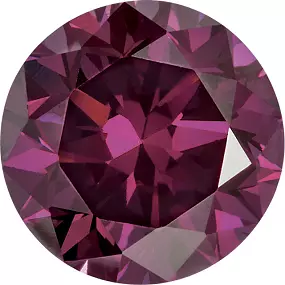 |
Purple: The most expensive of all purple diamonds are those that are uniformly pure purple without any secondary color modifiers. Known to represent creativity, femininity, love and romance. |
 |
Blue: Most years, only one natural blue diamond rough is mined, emphasizing how truly rare they are. Often associated with elegance and sophistication, blue diamonds promote calmness and serenity, truth and purpose. |
 |
Green: Natural green diamonds owe their color to radiation exposure that unfolded over millions of years during their formation. Believed to embody the essence of life, green diamonds promote youth, vitality and balance. Green is also the color of faith and truth and is often associated with loving and healthy relationships. |
 |
Chameleon: Chameleon diamonds got their name because they are the only diamond that can change color (often from green to yellow.) |
 |
Orange: Fancy orange diamonds are commonly found with modifying colors of brown and yellow and such diamonds are typically less expensive. Believed to inspired boldness, creativity, and productivity, orange diamonds are exotic and evocative. Orange is an emotional stimulant and is often linked to energy, self-respect and success within relationships. |
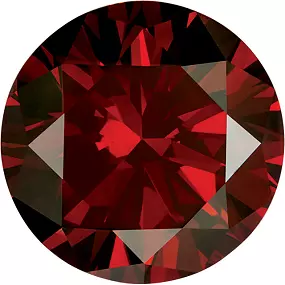 |
Red: Natural red diamonds are indeed so hard to come by that up to a mere thirty are known to exist. Symbolising passion and intense love, red diamonds are thought to inspire a magic that lasts a lifetime. As well as bringing good luck, red is known to channel power, energy and self-awareness. |
 |
Black: Black diamonds are opaque instead of translucent and owe their color to evenly distributed, dark inclusions. Symbolising strength and inner power, black diamonds are thought to bring the wearer the ability to face any adversities. Signifies belief in a relationship and the ability for the relationship to overcome all obstacles. |
 |
Violet: Natural violet diamonds are extremely rare and belong to the purple diamond family. A colored diamond is generally rare when it exists as one color without any modifying colors. Violet diamonds can be found paired with Blue and Gray. |
 |
Gray: Fancy gray diamonds are generally considered to rank among the most affordable color diamonds. |
 |
Champagne (Brown): Although a champagne diamond may look luxurious, its price is often quite affordable since the color is more abundant in nature. Often connected with the earth and nature, brown diamonds represent harmony and tradition. Brown diamonds fit in with all aspects of life and express subtle elegance, whilst signalling harmony within a relationship. |
Diamonds exist in practically all colors of the rainbow.
Among these main colors of diamonds, secondary color modifiers, and occasionally secondary base colors are often present to transform the overall hue, resulting in the creation of a unique colored diamond hybrid.
As mentioned, natural fancy colored diamonds are an entirely separate group that exists and is graded independently of colorless diamonds. The colorless (often called "white") diamonds are graded on a D-Z scale. This is because even colorless diamonds can have slight hints of color in the form of yellow or brown. However, colorless diamonds are prized for their lack of color, so these hints of yellow or brown negatively affect a diamond's value. The exact opposite is true for colored diamonds, where the color is the most important factor of value. All diamond colors, including a yellow or brown color diamond with color that is stronger than the D-Z scale, will be graded based on intensity of color. Intensity refers to the combination of tone and saturation. Tone is how much lightness or darkness exists in the diamond and saturation refers to the depth of color.
Also as mentioned, diamond color grading proceeds in the following ascending order of intensity: Faint, Very Light, Light, Fancy Light, Fancy, Fancy Intense, Fancy Vivid, Fancy Deep, and Fancy Dark. The more intense the color of diamonds, the more rare, and rarity determines overall value. For example: A Fancy Vivid Pink is rarer and more valuable than a Fancy Brown Yellow. Also:
A diamond with a light tone and light saturation is either Light or Fancy Light.
A diamond with a medium tone and deep saturation is Fancy Intense.
A diamond with a dark tone and deep saturation is Fancy Dark.
The most desired intensities are usually Fancy Vivid and Fancy Intense, the perfect marriage of tone and saturation.
We mentioned earlier that diamonds can have one or two base colors as well as color modifiers. The first color in a description is the modifier and the last is a base color. This means that a colored diamond can have:
One dominant (base) color: Example - Fancy Intense Yellow.
Two base colors: Example - Fancy Light Brown Pink.
One modifier two base colors: Example - Fancy Greenish Yellow Grey.
Two modifiers and one base color: Example - Fancy Dark Grayish Greenish Yellow.
Because of this amazing phenomenon, virtually all colors of diamonds exist to suit our uniquely individual tastes.
Colored diamond grading terminology uses a combination of fancy grades and color descriptions to define a diamond's characteristic color:

Grading terminology.
Hue is the dominant color of the diamond. It can be affected by the presence of 'modifiers' or 'tints', which are additional hues within a stone. A diamond can be a single color, such as pink, or it can have a secondary color, for example if a pink diamond had a purple tint, it would be described as a 'Purplish Pink diamond'.
A single color can potentially have multiple modifiers which are listed ahead of the primary color in the color description.
The color wheel illustrates each of the 27 hues used in the GIA standard to describe fancy colored diamonds.
The diamonds shown below as examples for each hue all have strong saturation levels. colors reach their strongest saturation at different tones, as you can see, the yellow diamond is lighter than the blue.

Hue chart.
Saturation refers to the strength or intensity of the hue of main color exhibited from the diamond. Saturation of diamonds with a lighter tone can range from 'light' to 'intense' to 'vivid'. For darker diamonds, descriptions can range from 'deep' to 'dark'.
The GIA system for color-grading fancy color diamonds is designed to accommodate the fact that not all colored diamonds have the same depth of color. For example, yellow diamonds occur in a wide range of saturations, while blue diamonds do not.
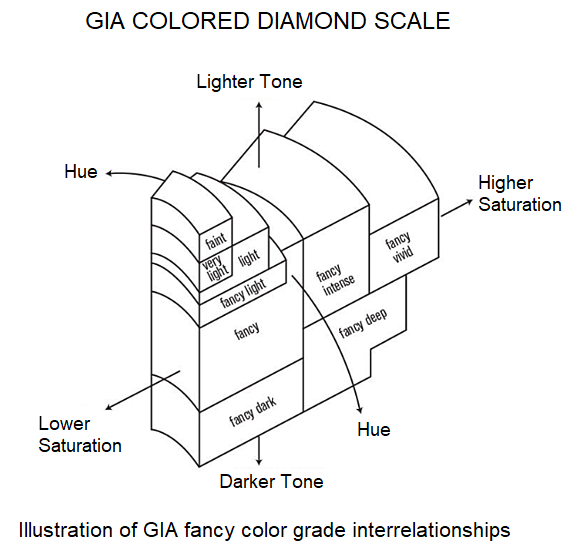
GIA colored diamond scale.
A good way to understand this is imagining a glass of red food coloring next to a glass with 2/3 water and 1/3 food coloring. The hue itself (red) has not changed, but the saturation would be more diluted, and lighter in tone.
Tone refers to how light or dark the diamond appears. This is typically determined by how much brown, black, grey or white is present in the stone.
Imagine the glass of food coloring. If you were to mix a little black food coloring with the red, its hue would still be red, the saturation would still remain the same, but it would be darker in tone.
Select a popular color range below to explore the range of tone and saturation found within each hue:
Yellow diamonds occur in some of the highest levels of saturation of any colored diamond. "Cooler" yellows sit toward the yellow/greenish-yellow hue boundary.
Unlike many of the other color charts, which start with Faint, Very Light, and/or Light, yellow diamond color grades begin with Fancy Light. This is because paler yellow diamonds are part of GIA's D-to-Z color scale which is used to categorise colorless diamonds.
The shaded areas, where no diamonds are illustrated, indicate areas in the yellow hue range in which diamonds are described as predominantly brown.

Yellow diamonds occur in some of the highest levels of saturation of any colored diamond. "Warmer" yellows toward the yellow/orangy-yellow hue boundary.
Unlike many of the other color charts, which start with Faint, Very Light, and/or Light, yellow diamond color grades begin with Fancy Light. This is because paler yellow diamonds are part of GIA's D-to-Z color scale which is used to categorise colorless diamonds.
The shaded areas, where no diamonds are illustrated, indicate areas in the yellow hue range in which diamonds are described as predominantly brown.

Orange-yellow diamonds occur in tones and saturations similar to those in the yellow hue.
It is in this hue range that most D-to-Z brown diamonds occur. As with yellow diamonds, there are no grades of Faint or Very Light in this hue range. However, unlike the yellow charts, diamonds described as predominantly brown are shown here.
Since the use of the term brown (or grey for cooler hues) is associated with color appearances that are weaker and or darker, the predominantly brown colors are located toward the lower left of the chart. In this hue, the term brown can be modified by yellow or yellowish.
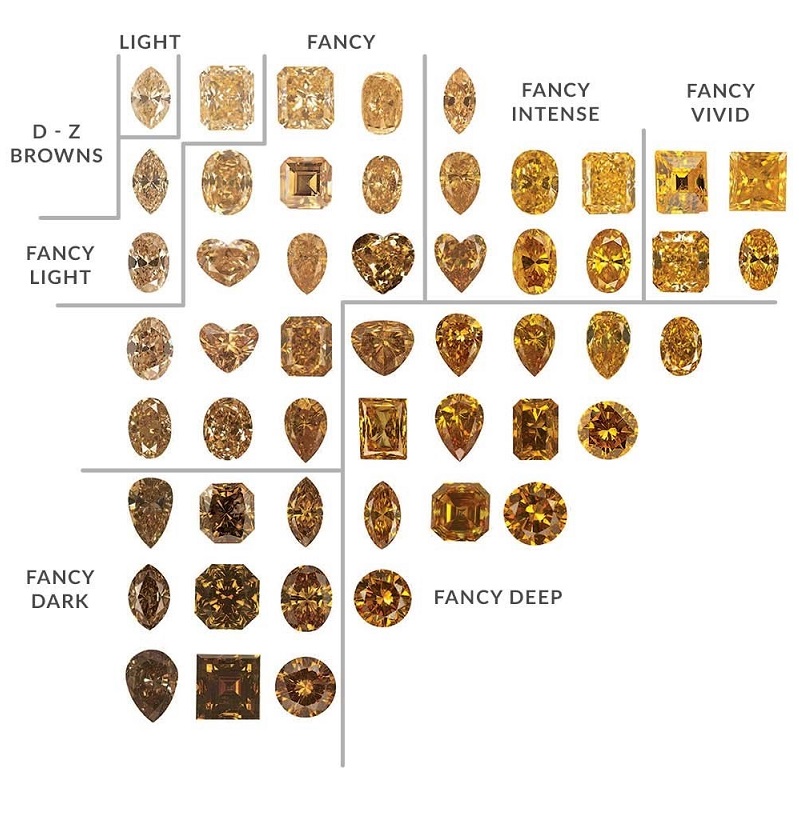
Yellow-orange diamonds occur in a wide tone range and reach their strongest saturation at a slightly darker tone than do yellow diamonds.
It's not unusual for diamonds in this hue range to be modified by brown or brownish.
Predominantly brown diamonds are shown toward the lower left on this chart and in this hue, the term brown can be modified by orange or orangy.
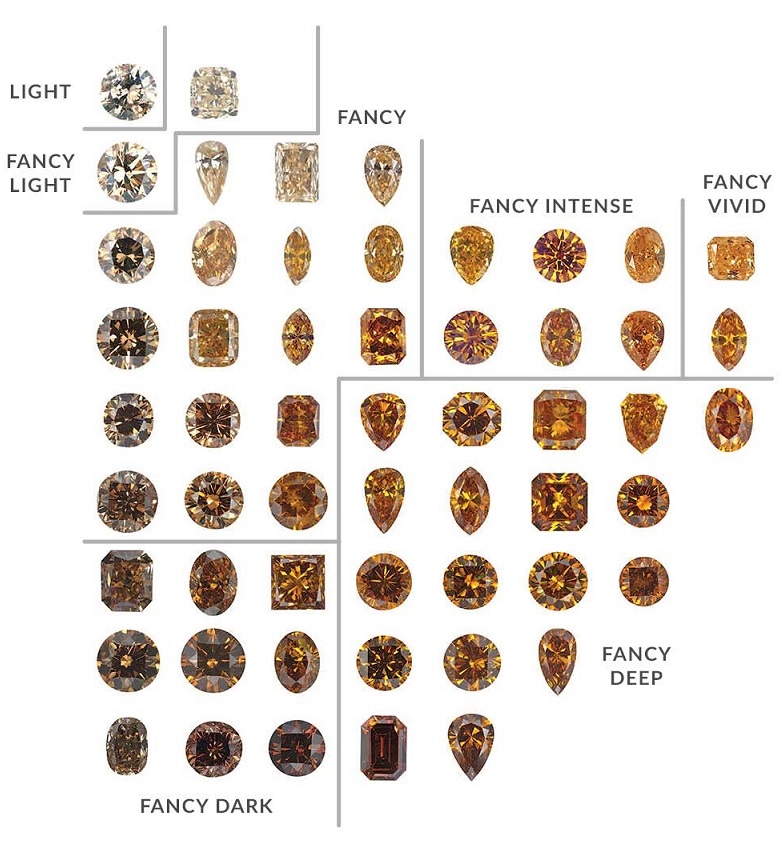
Diamonds in the orangy red hue do not typically reach as high a saturation level as those in yellow, orange-yellow, or yellow-orange. For this reason, the grades are slightly more compressed.
With the exception of the two orangy red diamonds at lower right, the diamonds represented on this chart are described as predominantly pink; that is, their descriptions do not end in the word brown.

Diamonds in the red hue occur in tones and saturations similar to those in the orangy red and purplish red hues.
Again, most of the diamonds represented on this chart would be described as predominantly pink. However this chart also includes examples of very dark colors that would be described as red-brown or reddish brown. The dark tones of these colors might be confused with saturation if not compared to known references.

Similar to diamonds in the orangy red and red hues, diamonds in the purplish red (most commonly, purplish pink) hue occur in a wide range of tones and reach their highest saturation at darker tones.
Unlike the majority of pink diamonds in the orangy red hue, the colors here are often zoned, which makes cutting choices with regard to face-up color challenging.
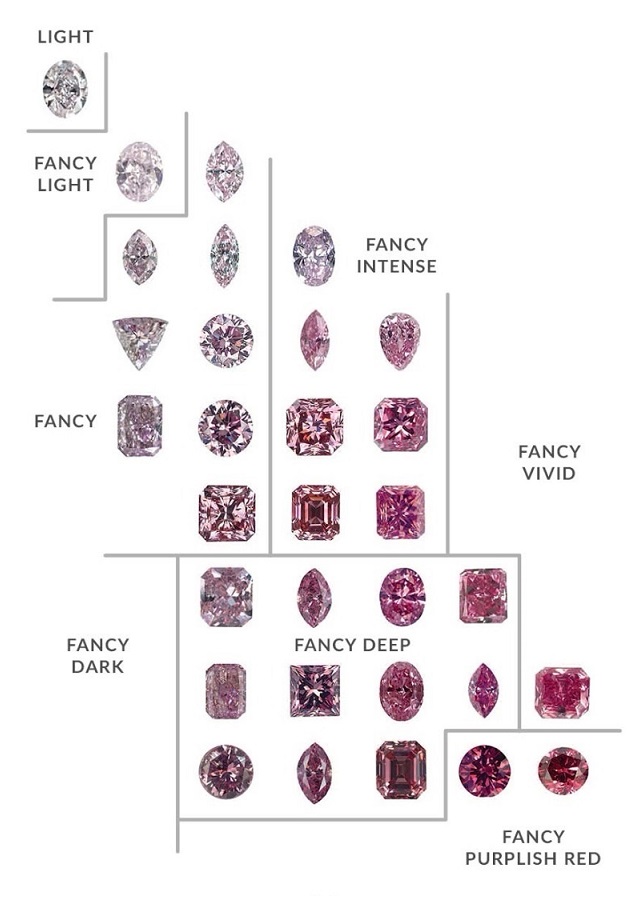
Blue diamonds occur in a relatively narrow saturation range, typically toward the neutral core of color space, but they vary widely in tone.
Blue diamonds reach their highest saturation at medium to dark tones, which are toward the lower right of the chart. The diamonds in the column on the far left represent an area of little discernible saturation where different appearances are primarily due to tone.

Yellow-green diamonds typically occur in slightly lower saturations and slightly darker tones than do yellow diamonds.
Yellow-green diamonds transition smoothly throughout their hue range. Weaker, darker colors appear predominantly grey. Such colors can be seen at the lower left on the chart.

Next to color grade, carat weight has the greatest effect on price. Smaller diamonds are typically mined much more often than large ones, which of course makes large diamonds much more rare and valuable. Because natural color diamonds are already rare, imagine how much rarer - and more expensive - a large natural fancy color diamond will be! So the larger the fancy color diamond, the higher the price will climb.
Clarity is the amount, size and type of imperfections, referred to in the diamond industry as "inclusions" that naturally exist within a diamond but cannot be easily seen, for the most part, by the naked eye. It is generally agreed that due to the microscopic nature of the inclusions, clarity does not negatively affect how a diamond looks (unless, of course, the inclusions are of the I3 variety and are accordingly so massive even the unaided human eye can see it).
A glaring difference between the importance of clarity in colorless diamonds and fancy color diamonds is that clarity amounts to nothing more than a mere afterthought in fancy color diamonds. Whereas clarity matters much more when it comes to premier colorless diamonds, in fancy color diamonds, the clarities are frequently in the SI-I range but, luckily, the inclusions often blend in with the color of the diamond, rendering them less invisible to the naked eye. The probability of fancy color diamonds having VS or better clarity is statistically small. When it does happen, such diamonds will of course carry a hefty price tag. The most important thing to look for in a fancy color diamond with respect to clarity is that it's eye-clean.
Fancy color diamonds are cut and polished differently from colorless diamonds in an effort to maximize their color. On the other hand, colorless diamonds are cut in a way that will produce the most brilliance, commonly referred to as sparkle. Excessive brilliance in a fancy color diamond can occasionally take away from the focus on its color, which is not what you want in these types of stones. Although fancy color diamonds can and do have brilliance, color trumps every other characteristic and is the one quality in these types of diamonds that carries the most weight (figuratively speaking).